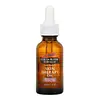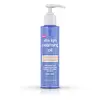What's inside
What's inside
 Key Ingredients
Key Ingredients

No key ingredients
 Benefits
Benefits

 Concerns
Concerns

 Ingredients Side-by-side
Ingredients Side-by-side

Prunus Amygdalus Dulcis Oil
Skin ConditioningVitis Vinifera Seed Oil
EmollientIsopropyl Myristate
EmollientCetearyl Ethylhexanoate
EmollientCamelina Sativa Seed Oil
Skin ConditioningMacadamia Ternifolia Seed Oil
EmollientSesamum Indicum Seed Oil
EmollientPEG-40 Sorbitan Peroleate
EmulsifyingCocos Nucifera Oil
MaskingPrunus Armeniaca Kernel Oil
MaskingCaprylyl Methicone
Skin ConditioningTheobroma Cacao Seed Butter
EmollientTocopheryl Acetate
AntioxidantRetinol
Skin ConditioningAscorbyl Palmitate
AntioxidantCentella Asiatica Extract
CleansingRosa Canina Seed Extract
EmollientArgania Spinosa Kernel Oil
EmollientHelianthus Annuus Seed Oil
EmollientDimethicone
EmollientHydrogenated Methyl Abietate
Parfum
MaskingCaprylic/Capric Triglyceride
MaskingBHT
AntioxidantBenzyl Benzoate
AntimicrobialCitronellol
PerfumingAlpha-Isomethyl Ionone
PerfumingGeraniol
PerfumingHydroxyisohexyl 3-Cyclohexene Carboxaldehyde
MaskingHexyl Cinnamal
PerfumingButylphenyl Methylpropional
PerfumingPrunus Amygdalus Dulcis Oil, Vitis Vinifera Seed Oil, Isopropyl Myristate, Cetearyl Ethylhexanoate, Camelina Sativa Seed Oil, Macadamia Ternifolia Seed Oil, Sesamum Indicum Seed Oil, PEG-40 Sorbitan Peroleate, Cocos Nucifera Oil, Prunus Armeniaca Kernel Oil, Caprylyl Methicone, Theobroma Cacao Seed Butter, Tocopheryl Acetate, Retinol, Ascorbyl Palmitate, Centella Asiatica Extract, Rosa Canina Seed Extract, Argania Spinosa Kernel Oil, Helianthus Annuus Seed Oil, Dimethicone, Hydrogenated Methyl Abietate, Parfum, Caprylic/Capric Triglyceride, BHT, Benzyl Benzoate, Citronellol, Alpha-Isomethyl Ionone, Geraniol, Hydroxyisohexyl 3-Cyclohexene Carboxaldehyde, Hexyl Cinnamal, Butylphenyl Methylpropional
Paraffinum Liquidum
EmollientIsopropyl Isostearate
EmollientC12-15 Alkyl Benzoate
AntimicrobialPolysorbate 80
EmulsifyingPEG-8 Caprylic/Capric Glycerides
EmulsifyingSorbitan Trioleate
EmulsifyingPolyglyceryl-3 Diisostearate
EmulsifyingCaprylic/Capric Triglyceride
MaskingWater
Skin ConditioningPEG-6 Caprylic/Capric Glycerides
EmulsifyingPPG-10 Cetyl Ether
Skin ConditioningBenzyl Alcohol
PerfumingParfum
MaskingPropylparaben
PreservativeButylene Glycol
HumectantGlycerin
HumectantRosmarinus Officinalis Leaf Extract
AntimicrobialCamellia Oleifera Leaf Extract
AstringentParaffinum Liquidum, Isopropyl Isostearate, C12-15 Alkyl Benzoate, Polysorbate 80, PEG-8 Caprylic/Capric Glycerides, Sorbitan Trioleate, Polyglyceryl-3 Diisostearate, Caprylic/Capric Triglyceride, Water, PEG-6 Caprylic/Capric Glycerides, PPG-10 Cetyl Ether, Benzyl Alcohol, Parfum, Propylparaben, Butylene Glycol, Glycerin, Rosmarinus Officinalis Leaf Extract, Camellia Oleifera Leaf Extract
 Reviews
Reviews

Ingredients Explained
These ingredients are found in both products.
Ingredients higher up in an ingredient list are typically present in a larger amount.
This ingredient is an emollient, solvent, and texture enhancer. It is considered a skin-softener by helping the skin prevent moisture loss.
It helps thicken a product's formula and makes it easier to spread by dissolving clumping compounds.
Caprylic Triglyceride is made by combining glycerin with coconut oil, forming a clear liquid.
While there is an assumption Caprylic Triglyceride can clog pores due to it being derived from coconut oil, there is no research supporting this.
Learn more about Caprylic/Capric TriglycerideParfum is a catch-all term for an ingredient or more that is used to give a scent to products.
Also called "fragrance", this ingredient can be a blend of hundreds of chemicals or plant oils. This means every product with "fragrance" or "parfum" in the ingredients list is a different mixture.
For instance, Habanolide is a proprietary trade name for a specific aroma chemical. When used as a fragrance ingredient in cosmetics, most aroma chemicals fall under the broad labeling category of “FRAGRANCE” or “PARFUM” according to EU and US regulations.
The term 'parfum' or 'fragrance' is not regulated in many countries. In many cases, it is up to the brand to define this term.
For instance, many brands choose to label themselves as "fragrance-free" because they are not using synthetic fragrances. However, their products may still contain ingredients such as essential oils that are considered a fragrance by INCI standards.
One example is Calendula flower extract. Calendula is an essential oil that still imparts a scent or 'fragrance'.
Depending on the blend, the ingredients in the mixture can cause allergies and sensitivities on the skin. Some ingredients that are known EU allergens include linalool and citronellol.
Parfum can also be used to mask or cover an unpleasant scent.
The bottom line is: not all fragrances/parfum/ingredients are created equally. If you are worried about fragrances, we recommend taking a closer look at an ingredient. And of course, we always recommend speaking with a professional.
Learn more about Parfum